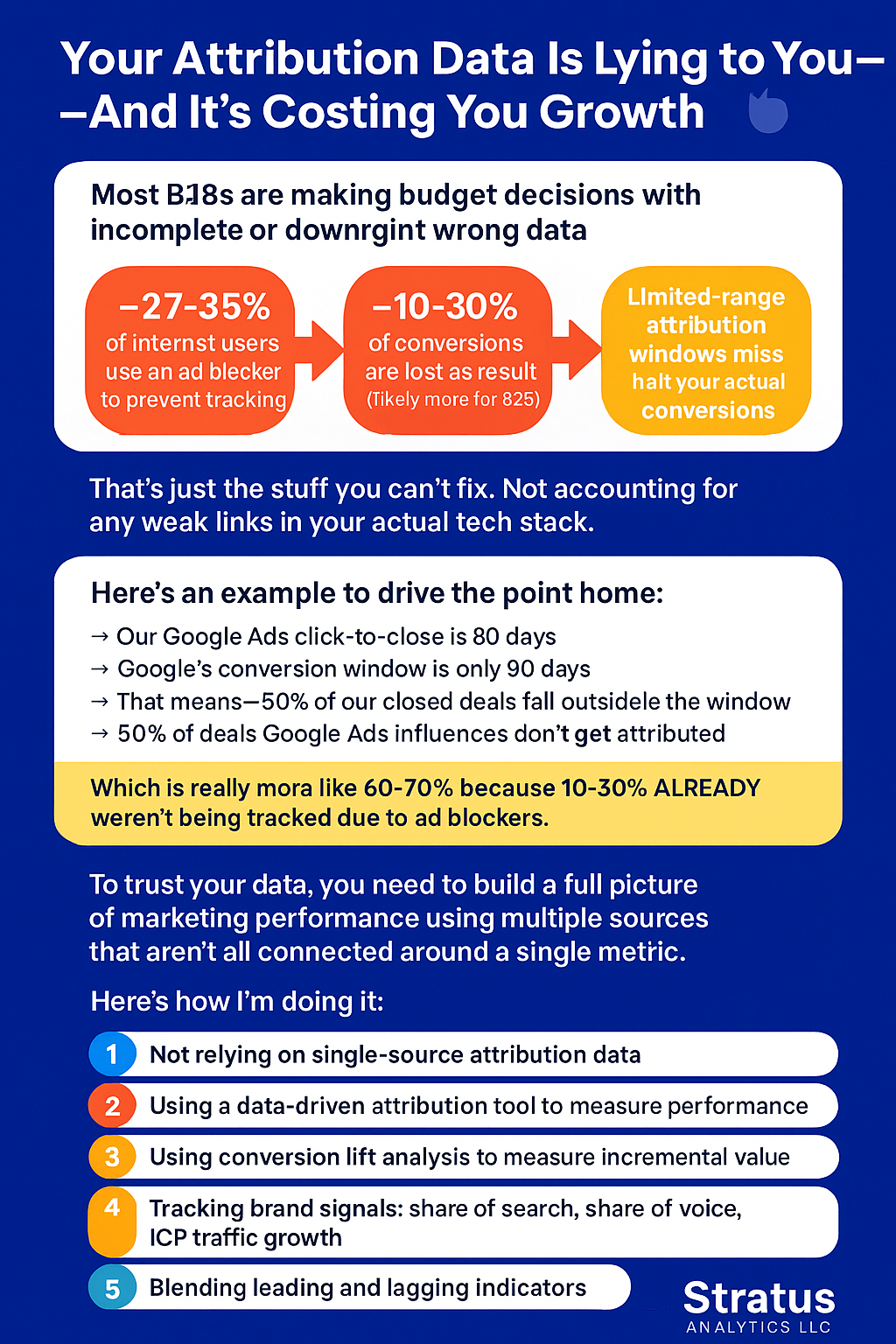Most B2B marketing teams think they’re making data-driven decisions.
In reality, many are basing their entire budget allocations on incomplete, distorted, or outright false attribution data.
Here’s the cold truth:
If you trust your default marketing attribution data, you’re making decisions based on lies.
And if you don’t recognize that now, you’re setting yourself — and your pipeline — up for painful surprises.
Let’s break this down.

The Invisible Gaps in Your Attribution
Even if you have the best MarTech stack in the world, the internet itself is working against your attribution efforts.
Here’s why:
- 27-35% of internet users block ads — meaning your pixel-based tracking can’t capture their actions.
- 10-30% of conversions are completely lost as a result.
- Attribution windows are too short — most are 30 to 90 days, while actual buying cycles (especially in B2B) are much longer.
And that’s before accounting for any internal tech stack issues like broken UTMs, misconfigured pixels, or CRM gaps.
In short: even if everything on your end was perfect (spoiler: it’s not), your attribution would still be fatally flawed.
A Real Example: Why You’re Missing Half Your Deals
Let’s make this painfully real.
Here’s a situation I’ve seen play out in real campaigns:
- Google Ads click-to-close time: 80 days.
- Google’s default conversion window: 90 days.
At first glance, that seems fine — the buying cycle fits within the attribution window, right?
Not really.
Because buyers don’t instantly convert after clicking an ad.
Many visit your site, then enter a long, complex B2B sales journey filled with research, demos, approvals, and contracts.
By the time they finally close, 50% of the original ad-influenced buyers have aged out of Google’s attribution window.
That means half of your paid search influence is completely invisible in the platform reporting.
And remember — 10-30% of conversions already weren’t trackable due to ad blockers.
So when you add that missing layer, you’re realistically missing 60-70% of the marketing impact.
In other words:
Your Google Ads dashboard isn’t just underreporting slightly.
It’s only showing you about one-third of reality.
What This Means for Your Marketing Decisions
When attribution data lies to you, your entire marketing strategy starts to crack:
- You kill campaigns that are actually profitable but “look bad” in the dashboard.
- You over-invest in channels that can be easily tracked, even if they’re lower quality.
- You undervalue brand, SEO, partnerships, and offline efforts because they don’t “attribute cleanly.”
- You train your organization to chase short-term, low-intent leads instead of building sustainable growth.
Worst of all:
You expose your budget to massive cuts because leadership only sees the (false) underperformance metrics.
How to Build a Truer Picture of Marketing Performance
The answer isn’t to give up on attribution — it’s to build a smarter system that blends multiple data sources.
Here’s how I’m approaching it:
1️⃣ Stop relying on single-source attribution data
If all your insights come from your ad platforms or your CRM alone, you’re flying blind.
Each system only shows you a piece of the puzzle.
Always cross-reference platform-reported numbers with first-party CRM data, call tracking, and survey responses.
2️⃣ Use a data-driven attribution tool
Platforms like Google Analytics 4, Adobe Analytics, or third-party tools like Triple Whale (for ecommerce) use machine learning to model attribution more realistically across channels.
No model is perfect, but data-driven attribution spreads credit based on real observed behaviors — not just last click.
3️⃣ Run conversion lift studies
When possible, run holdout tests (e.g., geo-split testing) to measure the incremental impact of campaigns.
Lift analysis gives you a true read on what happens when you don’t run ads — versus what ad reports alone imply.
4️⃣ Track brand signals
Not every important marketing movement shows up as a direct conversion.
Watch trends like:
- Share of search (how often your brand name is being searched)
- Share of voice (your brand’s presence in key paid/organic areas)
- ICP (ideal customer profile) website traffic growth
Brand growth indicators are often leading signs of future revenue.
5️⃣ Blend leading and lagging indicators
Don’t just stare at closed-won revenue (lagging indicator) or form fills (leading indicator) in isolation.
Blend both.
For example:
- Leading: Demo requests, newsletter signups, branded search growth
- Lagging: Revenue from those demos 3-6 months later
That way you’re evaluating marketing through both a now and later lens — not just who converted yesterday.
Why This Matters Now More Than Ever
The next few quarters are going to be brutal for a lot of B2B marketing teams.
Many CMOs are already facing budget cut demands in the name of “efficient growth.”
If you walk into those conversations armed only with weak attribution data, you’re going to lose.
Here’s what will happen:
- Your top-of-funnel programs will be first on the chopping block.
- Your brand equity will erode without you noticing.
- Your pipeline will thin out six months later when it’s too late to course-correct.
And all because the data looked like you weren’t delivering results — even though you were.
That’s why this isn’t just an analytics problem.
It’s a business survival problem.
Final Takeaway
You can’t completely fix attribution.
Some gaps are just part of the reality of modern marketing.
But you can — and must — build a more complete, resilient view of performance that doesn’t rely on any single platform or model.
If you start now:
- You’ll make smarter budget decisions.
- You’ll defend your spend when leadership comes knocking.
- You’ll grow pipeline and revenue more sustainably over the long haul.
Don’t let weak attribution send your marketing strategy off a cliff.
See the full picture.
Trust real signals.
Act accordingly.

Hi there! I’m Scott, and I am the principal consultant and thought leader behind Stratus Analytics. I have a Master of Science degree in marketing analytics, and I’ve have been providing freelance digital marketing services for over 20 years. Additionally, I have written several books on marketing which you can find here on Amazon or this website.
DISCLAIMER: Due to my work in the packaging industry, I cannot take on freelance clients within the packaging manufacturing space. I do not want to provide disservice to your vision or my employer. Thank you for understanding.
